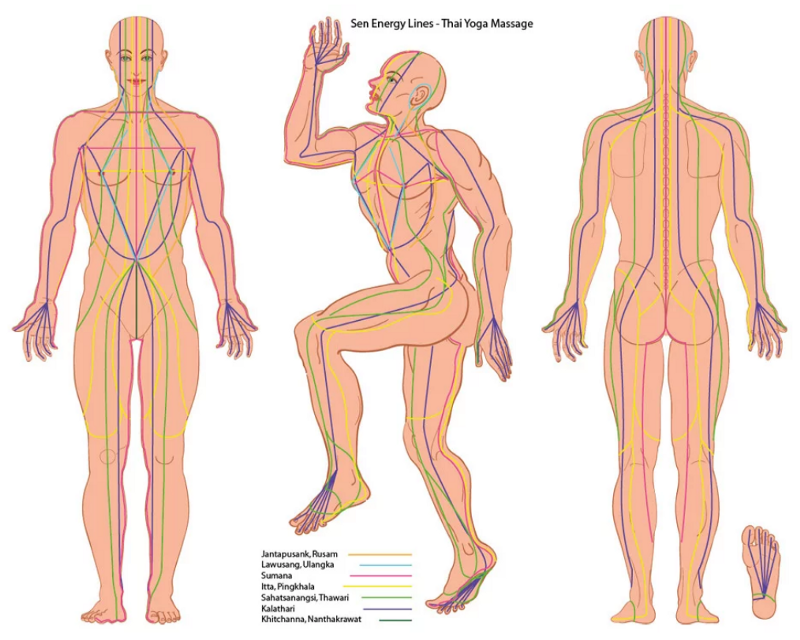
Continuation patterns in trending moves
11 June 2018
Oh Mind! Please Let Go
15 November 2020
The ‘Sen’ — the Meridians of Thai Massage
Why does Thai Massage feel so good? What does it do? And what’s going on in your body during and after a massage to produce such deep rest and relaxation?
I’ve been studying and practicing Thai Massage since 2016. I know it works — I experience its amazing effects everyday and see them in clients. I often get questions from people I work with about the practice and theory behind it, so my intention here is to delve deeply into the topic and shed some light on why the practice is like it is and why it is so different from other massage forms.
Massage tailored to your body
A fully trained Thai Masseur will ask you many questions about your health and want to know whether you have any physical or mental conditions you’d like help with. Your answers (alongside other factors such as your gender and body type) will determine how your practitioner approaches the massage — the pace of the treatment, the areas to work on and the amount of pressure to use. In the Thai medical system, conditions such as low energy, chronic pain and illness are associated with blockages or breaks in specific pathways in the body. These pathways are known as the ‘Sen’.
Depending on which teacher you follow, the Sen may be described as purely energetic phenomena, or they may be seen as corresponding directly to anatomical structures. But either way, unblocking these pathways during a massage brings greater flow and freedom of movement in the body, giving the receiver an overall sense of well-being and an energised calm.
A Thai Masseur works along these pathways, using their hands, feet, forearms and elbows to apply varying degrees pressure to your body. The lines also need to be stretched. To achieve this, your practitioner will use their whole body and through balance, counterweight and gravity, will lengthen and loosen your muscles and connective tissues.
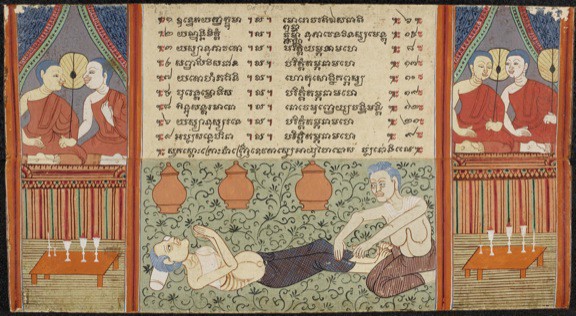
What are Sen?
This is the tricky part. There is no general agreement between practitioners and schools on exactly what the Sen are or on the paths they take through and across the body. There are said to be 72,000 lines but most people are familiar with just ten of them, the Sip Sen (or Sen Sib). There is some general agreement about the paths of the Sip Sen through the body and these form the basis of the sequences taught in massage schools.
“Contrary to Western style massage, traditional Thai massage does not primarily work with the physical body but rather with the energy body of man.”
Harald Brust (Asokanada) History of traditional Thai Massage
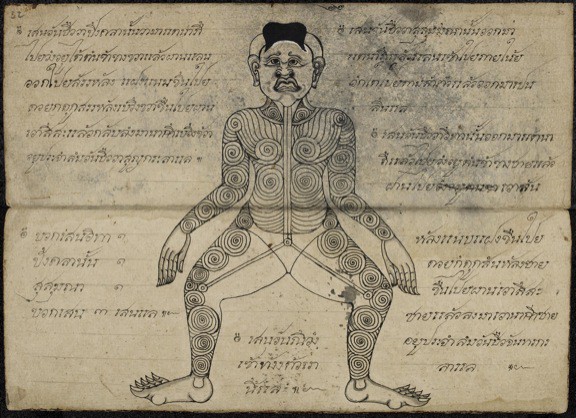
The diagram on the above (Or 13922, f. 32) indicates the channels and main pressure areas of the body, stylistically represented by spiralling calligraphic lines. One channel known as pinkhalā, for instance, begins at the navel and proceeds past the base of the right leg to exit via the back. Another channel, the susumannā line proceeds from the navel into the chest, climbs through the body and exits through the tongue.
Source http://www.asianmedicinezone.com/thai-se-asia/thai-massage-in-the-early-19th-century/

Here the pressure point above the right eye is identified as the one for treating pains and infections of the eye as well as dizziness. In the middle of the forehead is a point for treating headaches, fevers and congestion of mucus and haemorrhage in the nasal passage. (Or 13922, f. 36)
Source http://www.asianmedicinezone.com/thai-se-asia/thai-massage-in-the-early-19th-century/
Physical structures or energetic pathways?
In her book Thai Massage: Sacred Bodywork, Ananda Apfelbaum explains that there’s no satisfactory English translation of ‘Sen’, so we need to use an array of words to describe the concept. These include conduit, channels, fibres, filaments, narrow ridge, line, sinew and tendon. ‘Sen’ is also a prefix for anatomical Thai words for ‘lymphatic’, ‘blood vessel’, ‘artery’ and ‘vein’. Apfelbaum suggests that the best English word to use would be ‘conduit’. This encourages us to think of flow and movement rather than specific anatomical structures.
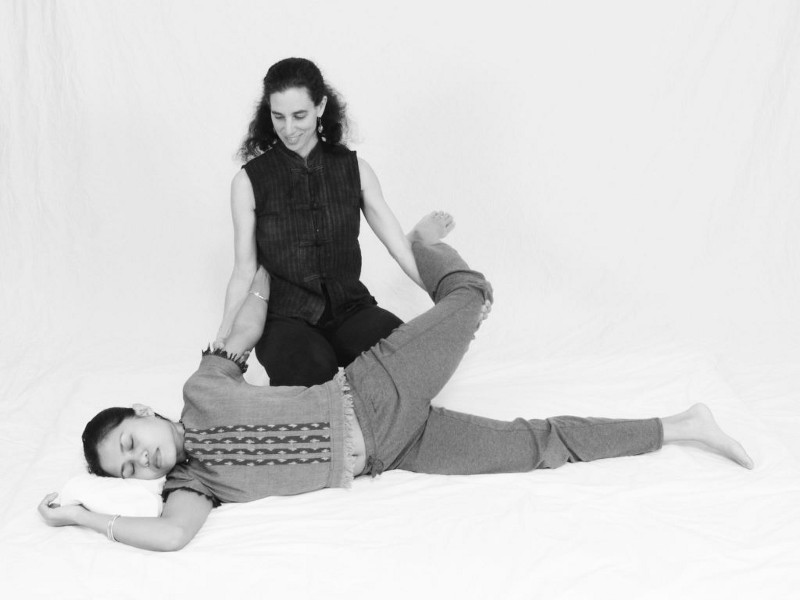
Different teacher, different interpretation
The different lineages and schools of Thai massage vary quite dramatically in their approach to the Sen. Until you understand this, it is very confusing to be a new student trying to learn about them — because the answer you get to nay question depends on who you ask.
Here are some quotes from established teachers on how they interpret the Sen:
For our intentions, my favorite explanation is that a Sen is a “physical pathway by which movement occurs in the body.”
For the most part, Sen are tangible structures. Most of the Sen that we work with in the body are tendons, ligaments, veins, nerves and arteries. They also also sometimes refer to muscular and fascial pathways.
Nephyr Anne Jacobson in her book Traditional Thai Medical Theory for Bodyworkers, Findhorn Press 2015.
Thai texts mention red, black and white Sen. which correlate roughly with arteries, veins and nerves. However, the main Sen used in Thai massage seem to correlate most strongly with networks of myofascial tissue (which structural integrations call the ‘anatomy trains’). The lines for the most part follow the grooves in between muscles, connecting important insertion points to one another.
Dr. C. Pierce Salguero and David Roylance in their book Encyclopedia of Thai Massage — A Complete Guide to Traditional Thai Massage Therapy and Accupressure, Findhhorn Press 2011
The word ‘Sen’ in the Thai language means string, or pathway. It is the movement of energy along these channels that maintains health. The ‘Sen Sip’ are the most important channels in the human body….
The body is a vehicle to access the human energy system, so relying entirely on anatomy to find the lines can create confusion. Where there is injury, illness or damage to the body, the sen can change their qualities. Maps and line charts cannot show you exactly where the individual Sen lie; this is something you must feel and sense and learn when you touch your client’s body.
Felicity Joy in Thai Massage and Thai Healing Arts by Bob Haddad, Findhorn Press 2013
Flow of energy in the body
Energy flows freely around a normal, functionally healthy body. Every second, you are consciously and unconsciously perceiving your environment and responding to the feelings and impulses that arise from your perceptions.
If you feel love for the person you are with, you will direct your energy towards the person, your feelings for them and your relationship. In this state, you often have a certain glow, and can be quite magnetic — other people will generally feel good around you. If you are fearful, your energy will be directed towards defence, protection and escape; when you are sad, the energy will be focused on the source of the pain — so it will be directed inwards, towards the experiencer of the suffering.
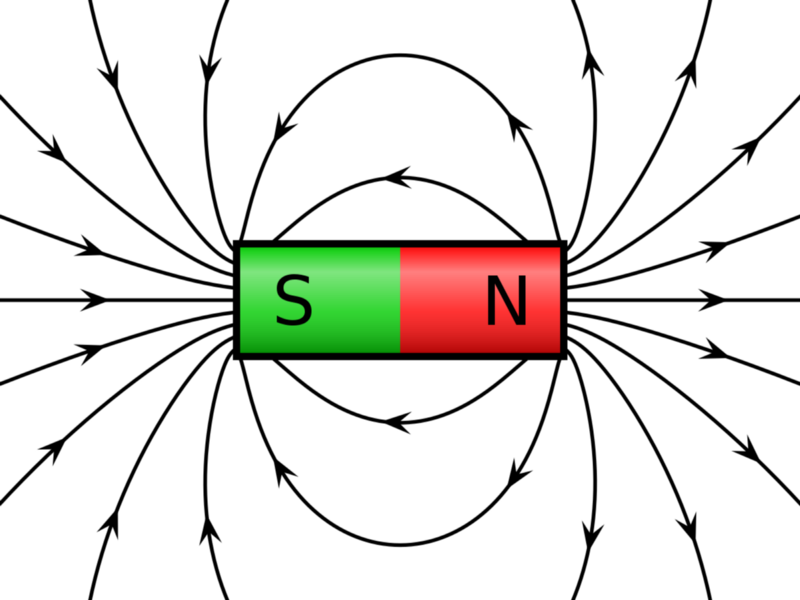
When these emotional states become chronic rather than transient, the energy gets stuck. Most of us are familiar with people who seem to be fixed in a state of defence or attack, or who seem locked into a state of overwhelm or low energy — and we have probably experienced this ourselves. Our body initially responds appropriately to the situation: it’s good to defend yourself and loved ones against an external threat; and resting when you’re tired and stressed is the right thing to do. Problems arise when these responses remain long after the threat or stress has passed. When this happens, the flow of energy around the body declines and this is expressed as habitual tension patterns, imbalances, constricted movement and poor posture.
‘Lom’ and blocked or broken Sen
In place of the non-specific ‘energy’, the correct term to use in Thai Massage is ‘Lom‘ or Lom Pran. This is similar to chi in Chinese medicine and prana in yogic systems. If this flow of Lom is in any way impeded by blockages or breaks in the Sen, you will experience less-than-optimum health.
Long-held tensions in muscles and connective tissues — as described above — can result in such blockages.
Breaks in the Sen can be caused by injuries such as sprains and tears in connective tissue.
The goal of Thai Massage is to correct the Lom imbalances by stimulating the affected Sen and thereby restoring your full function and vitality.
Be very wary of looking at a person’s posture or tension patterns and drawing simplistic conclusions about them as a person. According to Tom Myers of AnatomyTrains.com, posture is the result of a complex interaction between genes, life experience, imitation of parents or significant others in early life and sometimes injuries. So avoid presumptive interpretations of a person’s state just by observing them on a superficial level.

An aside on the use of the word ‘energy’
Whenever I use the word ‘energy in this context, I remember a conversation with a friend who said that they found this use of the word meaningless therefore irritating. I knew exactly what he meant…
In bodywork, we are almost always addressing mental and physical together, so we need a word that encompasses both realms. So far, I have not found a better English word to do this job.
For example:
– When the energy is balanced and flowing freely, we can easily shift our attention from one activity to another — and maintain it when necessary — and we have ease and aliveness in our body.
– When we are more challenged and the energy is blocked, attention is rigid and stubborn or so flighty we can’t achieve anything. Our bodies don’t easily respond to what’s required of them — perhaps so heavy and slow that even the tiniest movement seems like a monumental effort or maybe so fidgety that we are unable to relax and switch off.
The Sip Sen or Sen Sib
Of the 72,000 Sen, only ten — the Sip Sen — are well understood by practitioners and used in general Thai Massage. The Sip Sen include:
- Sen Sumana
- Sen Kalathari
- Sen Itta and Pingkhala
- Sen Sahatsanangsi and Thawari
- Sen Lawusang and Ulangka
- Sen Khitchanna and Nanthakrawat
As I said above, each teacher and school sees the Sen differently, so no single map of the lines can be taken as a definitive truth. Some traditions will include just a single main line, while others will include numerous branch lines extending from the main line.
Here’s a sketch of one interpretation of the paths of the Sip Sen:
